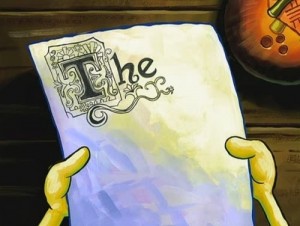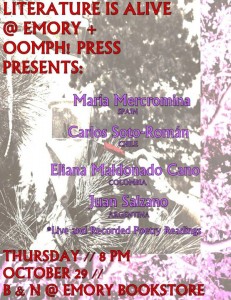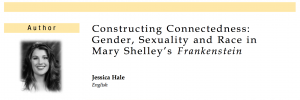[gview file=”http://scholarblogs.emory.edu/writingscifi/files/2015/12/181.Oviedo.portfolio1.pdf”]
Author Archives: koviedo
Karol Oviedo Post #12
Good morning!
My name is Karol Oviedo, and I will be your guest lecturer for this section of this 181 course, Writing about Science Fiction Literature and Film. Your Professor is in Spain as we speak.
Today, we will be talking about the theme “Entering Class Discussions.” An overview of today’s class will be: an icebreaker, perceptions of entering class discussions in high school, and how different it is entering a class discussion in college. Since most, if not all of you, are First-Year Students, you might remember how high school discussions went. The teacher would pose a question, a student would answer, one would agree or disagree and the conversation continued. In college, this might differ a bit. But I am getting ahead of myself. I would love to meet your first. Let us do an icebreaker. Everybody, get on your feet and lets stand in a circle. You will say your name and a movement. For example, I will say Karol while making a piece sign with my fingers.
In this Eng 181 course, entering the discussion involves a small convention that one should follow. This convention includes: stating the name of the last person who spoke (this will help you remember their name), summarize what they have mentioned briefly (this will allow you to make clear any misunderstandings), and extend or refute on what the previous person has argued (if possible, include references to the text being discussed or any other source that contributes to the discussion). Any questions? No? All right.
To be able to put all of this information into practice, let us set the chairs in a circle. Let us read this article by Clay Shirky, a professor of media studies at NYU.
Here is the link: https://medium.com/@cshirky/why-i-just-asked-my-students-to-put-their-laptops-away-7f5f7c50f368
After reading this article, the topic question for today is; should laptops, tablets, phones, and other technological devices be allowed during lecturers? Please, when you answer, cite the article accordingly…
Karol Oviedo Post #11
“There, I’m done!” says Karol as she finishes the first draft of her paper. “No wait, let me fix these typos first… does this sentence make sense with the rest of the paragraph… should I include more details to make my ideas more clear… should I replace this sentence with this one…” Finally, writing is a process. The moment where you, as a writer, feel that your final draft is complete, that is the perfect moment to return to your writing and improve it.
Writing is a challenge given that my first language is Spanish and I constantly translate my ideas from Spanish to English. Most of the time this works, but other times it is a complete disaster! Spanish idioms are completely different from English idioms. This difference impedes me from completing a clean English piece of writing. Nonetheless, I do not allow my imperfections to dull my willingness to write. In class, Professor Starr constantly mentions that writing is a social activity where different writers engage in conversations. I implemented this idea to my “Karol Oviedo Post #4” where I continue with the conversation of the dystopian society in the book Super Sad True Love Story by Gary Shteyngart. I say, “according to girls’ behavior in this book, they have to receive respect by having their significant other be aware that they could have an affair with others also. To this day, that action is not deserving of respect […]” This quote emphasizes how Grillbitch allows herself to be mocked. As a way of demonstrating she deserves respect, she decided to make herself look like she is surrounded by other men who are taking advantage of her. I contributed to this conversation by saying that this immorality comes from the dystopian society she lives in.
Another way to look at how writing is a conversation is when one is discussing the reading. The most imperative deed when engaging in a group discussion is to listen to what others have to say in order to react to it. If one does not listen, the conversations will remain one-sided.
Karol Oviedo Post #10
Reflect on your past writing:
On my past writing in general, I tried to generate an inverted pyramid of importance. The first sentence would place a general idea that would leave the readers curious. This curiosity would leave the reader with a desire to read the entire first paragraph — and hopefully the entire paper. Then, I tried to develop a description for the topic and end with the thesis statement. My idea of the structure is set, but my difficulty is bringing that idea to reality. As to the my conclusions in past writing, I tried to restate the thesis and present the points I mentioned in the writing that explained and supported my thesis.
A piece of writing:
“Multiple Personality Murder” by Deborah Karczewski
This monologue, for the soul purpose of a clear theatrical structure, is written with clear annotations noted throughout the play. Focusing on the introduction, the author uses the chronological system of organization to allow the reader follow on her flow of words. She guides the reader through the setting of the place by providing a spatial description of the room and represented each movement as parallel as possible with each word the character would utter. This is an example of her spatial description, “The first is her ‘guard’ beside her, and the second is the ‘psychiatrist,’ placed eye level beyond the audience…” This quotes offers both the location of the actress and the location of the imaginary psychiatrist and guard. After this spatial description, the author proceeds with the play. She creates a character that has multiple personalities. Each personality contributes to what will happen later in the plot, but the author does not explicitly say what will occur as the monologue advances because she wants to hook the reader. Personally, I would like to incorporate her diction to attract the attention of my readers with a nice hook.
Karol Oviedo Post #9
EFFECTS OF DESIRE: OUTLINE
“DETRIMENTAL HUMAN BEING DESIRES: AN APPROACH TO ADDRESS THE SOCIAL ISSUES OF DESIRE”
I. PSYCHOLOGY OF DESIRE SHOWN IN FRANKENSTEIN
A. Evaluate Victor Frankenstein’s behavior before the creation of the monster
B. Evaluate Victor Frankenstein’s behavior after he gave life to the monster
1. Description of his disgust because of the monster’s physical features
2. Include description of how Victor Frankenstein was affected
a. Physically with the deterioration of his health
b. Psychologically
(1) Behavior – constant isolation
(2) Ruminance – revive in his mind his pain
II. BELIEFS, DESIRES, AND INTENTIONS AND THEIR NEGATIVE CONSEQUENCES
A. Relationship between belief, desire, and intentions (BDI Agents)
B. Social psychology used for negative purposes
1. Conformity, Deindividuation, and Obedience
2. Introduce the maximum perpetrator of mass genocide Adolf Hitler
III. HISTORICAL FIGURES AS EXAMPLES OF DESIRE
A. Adolf Hitler and his desire to “purify” the German race
B. Thomas A. Edison and his light bulb
1. Persistence is not always negative – as a counterargument
2. Good intentions, bad consequences
3. Cheating as a defense mechanism
a. Pressures on careers, family
b. Merely personal wishes
Karol Oviedo Language is Alive poetry reading
My response to this sparkful night is in verse
Because in verse is how the curse
Is able to disperse and the nurse
named Translator can cure
This pure and at times obscure
Words that flow free as birds
Language
You are the one to blame
And the one to thank
I blame you for not being enough
I thank you for allowing the tough
Task of communication
So diverse and converse
So great and limited
So spacious and narrow
Dear Language,
You have many last names
Sir English and Mother Spanish
From one to the other poetry goes
As a boat stranded at sea
From one to the other words flow
Sometimes losing its essence
From one to the other language grows
Sometimes losing its melody
From one to the other glows
Sparkle, dull, soft and numb
Yet always preserving its purpose
Language, altered throughout time
What a crime to be the spine of
All the vice that once sublime
And lost in the climb of a pine
Sometimes losing the prime
Desire to comply with your own shine
My response to this night is in rhyme
Because in rhyme we could
Taste the sweet lemon of words
Smell the aromatic black print
Touch the paper in tears
Hear the beat of letters
See the author’s heart
Karol Oviedo Post #8
One of the primary sources I have used is available on my post #4. I use a fragment from the book Super Sad True Love Story by Gary Shteyngart that describes how the character Grillbitch was at rage with her boyfriend after she discovered he was cheating on her. The quotation was, “I went on this new Teens site called ‘D-Base’ where they can digitize you like covered in shit or getting fucked by four guys at once and I sent Gopher all these Images of myself getting fucked by four guys at once.” I was able to integrate this quotation by describing what was it that Grillbitch said and then described how ironic it was that according to the book in order to receive respect, you had to “get fucked by four guys.” I was able to introduce the quote by describing the author and the source, and indicate how it relates to my text. But if I were to change it, I would write:
The author Gary Shteyngart introduces a dystopian situation in his book Super Sad True Love Story by exaggerating the way in which a female, in this case Grillbitch, would react if her significant other were to be unfaithful to the relationship. Grillbitch says, “[insert quote here]” After reading these words, one might question her behavior because in these times, if you use your body like that, you would lose respect, not gain it.
One of the secondary sources I used is on my post #5. In that article about the downsides of technology in school, the author says, “what the U.S. education system needs above all isn’t more technology, but a deliberate allocation of high-quality adult supervision focused on those who need it most.” I integrated the quotation by introducing most arguments about technology, the author and the name of the article. I also explained what it meant and was able to relate it with the book Super Sad True Love Story. I would change the way in which I presented this quotation and write this:
The author Kantaro Tomaya is adamant that “[insert quote here]” after discovering that the technology is only a source of distraction to the students. He expresses, in other words, that technology’s primary function is to entertain, not help the students to focus.
Karol Oviedo Post #7
Link of the article: http://jhp.sagepub.com/content/41/4/57.full.pdf+html
“Making Daemons of Death and Love: Frankenstein, Existentialism, Psychoanalysis”
By Will W. Adams, Psychologist
Summary of the author’s argument:
Both existentialism and psychoanalysis play a huge role in the creation and development of the characters in the book Frankenstein by Mary Shelley. The reader might take note of the topics such as death-repression, the return of the repressed and the daemonic. In Frankenstein, the Mary Shelley challenges death (in the living creature Victor Frankenstein has created), love (in the isolation Victor faces), nature (in how Victor evades it), and spirit (in the alterations of real spiritual encounters). The author Mary Shelley was able to channel her conflicts and desires into an everlasting book.
Critic:
The author Will W. Adams uses Rollo May (1969)’s observation that “The daemonic ‘is potentially creative and destructive at the same time’” (Adams 62) In this case, the author is extending what the critic Rollo May suggested. He affirms that “daemonic energy is available for us to take up, respond to, and channel as best we can.” He suggests that the manner in which a person reacts to the presence or the idea of a deamon will affect the outcome of the behavior of that deamon. Will W. Adams says,
“If we respond with openness and understanding, then our daemons tend to be integrated as benevolent, creative, energetic guides to transformation and health. But if we react with defensive avoidance, they tend to appear as malevolent, destructive sources of suffering.”
Develop an angle for your own paper:
I would like to explore the identity of both the narrator Victor Frankenstein and his monster using this article to help me develop a psychoanalysis. By extending, or sometimes refuting, on what the author Will W. Adams portrays in his research, I will be able to formulate my own opinions and have them backed up by other researchers.
In other words, Will W. Adams will aid me to engage in the conversation he forms part of when it comes to the identity and psychoanalysis in Mary Shelley’s Frankenstein.
Karol Oviedo Post #6
In her paper “Constructing Connectedness: Gender, Sexuality and Race in Mary Shelley’s Frankenstein,” the college student Jessica Hale presents the interesting argument of the inarguable homosocial relationships. Her main point with this argument is that “the most intimate relationships on the novel occur not between husbands and wives, but between men and their male friends.” (parr. 5)
Jessica Hale has these exemplary sections of the passage that undoubtedly support her argument of the presence of homosocial relationships. One of the close readings of the passage from Frankenstein is “many a long were the conversations between Lord Byron and Shelley to which I was a devout but nearly a silent listener.” (xxiv) The author uses this passage to describe that probably, Mary Shelley’s experience seeing Lord Byron and Shelley “provided material” (parr. 5) for the proclaimed homosocial interactions in Frankenstein.
Besides referencing her primary source, which in this case is the text Frankenstein itself, Jessica Hale uses secondary sources. She explained Berthold Schoene-Harwood’s perspective when she quotes, “the predicament of the individual male psyche under patriarchal pressure.” (parr. 5) The purpose of this secondary source was to describe, using evidence, that the pressure Victor flees is “the role of a husband and father providing for and perpetually tied to a nuclear family.” (parr. 5)
In the very first sentence of this literary study, Jessica Hale uses the term “encroached.” As an English language learner, one cannot refuse to search up the dictionary for the definition. Not possessing a physical dictionary, accessing the web in “dictionary.reference.com,” the definition of encroached in my own words is to be a able to go beyond the limits the environment establishes.
To recap, Jessica Hale empowers a main argument which she evidences with close reading and utilizes secondary sources and appropriate terms in order to voice her points.
Karol Oviedo Post #5
Surveillance technology, Global Positioning System, Social Media, Technology, Technology, Technology. All this discussion on technology is everlasting. Arguments about how bad it is to the ecosystem, how it makes human behavior be altered, how technology evolves and will eventually destroy itself, how information is easily accessible and how dangers are equally accessible, and the arguments continue. In the discussions, most affirm that there are more cons than pros when it comes to technology, yet, it is with the very means of technology that you, dear reader, are able to access this blog post. Therefore, technology shouldn’t be that downgrading, right?
Contrary to the thought that technology should not be very degrading is Kantaro Tomaya’s point in the article “Why Technology Alone Won’t Fix Schools.” In this article, the author informs on the last paragraph that “what the U.S. education system needs above all isn’t more technology, but a deliberate allocation of high-quality adult supervision focused on those who need it most.” Kantaro Tomaya is implying that technology is not that necessary when it comes to education because what is does the most is distract instead of placing the owner of technology on track. This relates to Gary Shteyngart’s book Super Sad True Love Story when the protagonist Lenny Abramov encounters the sad truth that young ones have committed suicide because their apparats were not functioning to its full abilities. On page 270 of Super Sad True Love Story, Shteyngart approaches this dystopian society with a scene like this: “Four young people committed suicide in our building complexes, and two of them wrote suicide notes about how they couldn’t see a future without there apparati.” When technology has this downfall, it is challenging to see the perks of it.
Toyama, Kentaro. “Why Technology Alone Won’t Fix Schools.” The Atlantic. Atlantic Media Company, 3 June 2015. Web. 8 Oct. 2015. .



